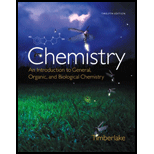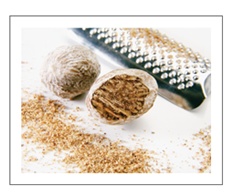
Chemistry: An Introduction to General, Organic, and Biological Chemistry (12th Edition) - Standalone book
12th Edition
ISBN: 9780321908445
Author: Karen C. Timberlake
Publisher: PEARSON
expand_more
expand_more
format_list_bulleted
Concept explainers
Textbook Question
Chapter 15, Problem 30CI
Glyceryl trimyristate (trimyristin) is found in the seeds of the nutmug (Myristica fragrans). Trimyristin is used as a lubricant and fragrance in soaps and shaving creams. Isopropyl myristate is used to increase absorption of skin creams. Draw the condensed structural formula for each of the following: (15.2, 15.3, 15.4)

Nutmeg contains high levels of glyceryl trimyristate.
- Myristic acid (14:0)
- Glyceryl trimyristate (trimyristin)
- Isopropyl myristate
- Products from the hydrolysis of giyceryl trimyristate with an acid catalyst.
- Products from the saponification of glyceryl trimyristate with KOH
- Reactant and product for oxidation of myristyl alchohol to myristic acid
Expert Solution & Answer
Want to see the full answer?
Check out a sample textbook solution
Students have asked these similar questions
Draw orbitals for a and c and identify all of the molecules/functional groups' electron
geometry, molecular shape and bond angles:
a. H₂O
b. Ketone
c. Alkyne
d. Ether
Identify the functional groups in the following molecule, naxalone (aka narcan):
HO
OH
N
Benzene-toluene equilibrium is often approximated as αBT = 2.34. Generate the y-x diagram for this relative volatility. Also, generate the equilibrium data using Raoult’s law, and compare your results to these.
post excel spreadsheet w values used to generate both graphs
Chapter 15 Solutions
Chemistry: An Introduction to General, Organic, and Biological Chemistry (12th Edition) - Standalone book
Ch. 15.1 - Prob. 15.1QAPCh. 15.1 - Prob. 15.2QAPCh. 15.1 - Lipids are not soluble in water. Are lipids polar...Ch. 15.1 - Which of the following solvents might be used to...Ch. 15.2 - Describe some similarities and differences in the...Ch. 15.2 - Prob. 15.6QAPCh. 15.2 - Prob. 15.7QAPCh. 15.2 - Draw the line-angle formula for each of the...Ch. 15.2 - Prob. 15.9QAPCh. 15.2 - For each of the following fatty acids, give the...
Ch. 15.2 - Prob. 15.11QAPCh. 15.2 - How does the double bond influence the dispersion...Ch. 15.2 - Prob. 15.13QAPCh. 15.2 - Prob. 15.14QAPCh. 15.2 - Prob. 15.15QAPCh. 15.2 - Prob. 15.16QAPCh. 15.2 - Prob. 15.17QAPCh. 15.2 - Prob. 15.18QAPCh. 15.3 - Draw the condensed structural formula for the...Ch. 15.3 - Prob. 15.20QAPCh. 15.3 - Prob. 15.21QAPCh. 15.3 - Draw the condensed structural formula for a mixed...Ch. 15.3 - Prob. 15.23QAPCh. 15.3 - Prob. 15.24QAPCh. 15.3 - Prob. 15.25QAPCh. 15.3 - Prob. 15.26QAPCh. 15.4 - Identify each of the following processes as...Ch. 15.4 - Identify each of the following processes as...Ch. 15.4 - Prob. 15.28QAPCh. 15.4 - Prob. 15.29QAPCh. 15.4 - Prob. 15.30QAPCh. 15.4 - Prob. 15.31QAPCh. 15.4 - Prob. 15.32QAPCh. 15.4 - Prob. 15.33QAPCh. 15.4 - Prob. 15.34QAPCh. 15.4 - Prob. 15.35QAPCh. 15.4 - Draw the condensed structural formula for all the...Ch. 15.5 - Prob. 15.37QAPCh. 15.5 - Prob. 15.38QAPCh. 15.5 - Prob. 15.39QAPCh. 15.5 - Prob. 15.40QAPCh. 15.5 - Prob. 15.41QAPCh. 15.5 - Prob. 15.42QAPCh. 15.5 - Prob. 15.43QAPCh. 15.5 - Prob. 15.44QAPCh. 15.6 - Draw the structure for the steroid nucleus.Ch. 15.6 - Draw the structure for cholesterol.Ch. 15.6 - Prob. 15.47QAPCh. 15.6 - Prob. 15.48QAPCh. 15.6 - Prob. 15.49QAPCh. 15.6 - Prob. 15.50QAPCh. 15.6 - Prob. 15.51QAPCh. 15.6 - Prob. 15.52QAPCh. 15.6 - Prob. 15.53QAPCh. 15.6 - What are the similarities and differences between...Ch. 15.6 - Prob. 15.55QAPCh. 15.6 - Prob. 15.56QAPCh. 15.7 - What is the function if the lipid by layer in a...Ch. 15.7 - Prob. 15.58QAPCh. 15.7 - Prob. 15.59QAPCh. 15.7 - How do the unsaturated fatty acids in the...Ch. 15.7 - Prob. 15.61QAPCh. 15.7 - Prob. 15.62QAPCh. 15.7 - Prob. 15.63QAPCh. 15.7 - 15.66 Identify the type of transport described by...Ch. 15 - Prob. 15.65UTCCh. 15 - Prob. 15.66UTCCh. 15 - Prob. 15.67UTCCh. 15 - Prob. 15.68UTCCh. 15 - Prob. 15.69AQAPCh. 15 - Prob. 15.70AQAPCh. 15 - Prob. 15.71AQAPCh. 15 - Prob. 15.72AQAPCh. 15 - Prob. 15.73AQAPCh. 15 - Prob. 15.74AQAPCh. 15 - Identify each of the following as a fatty acid,...Ch. 15 - Identify each of the following as a fatty acid,...Ch. 15 - 15.81 Identify the components (1 to 6 ) contained...Ch. 15 - Prob. 15.78AQAPCh. 15 - Prob. 15.79AQAPCh. 15 - Prob. 15.80AQAPCh. 15 - Draw the condensed structural formula for a...Ch. 15 - sunflower seed oil can be used to make margarine....Ch. 15 - 15.89 A sink drain can become clogged with solid...Ch. 15 - 15.90 One of the triacylglycerols in olive oil is...Ch. 15 - The plastic known as PETE...Ch. 15 - Using the Internet, look up the condensed...Ch. 15 - The insect repellent DEET is an amide that can be...Ch. 15 - Glyceryl trimyristate (trimyristin) is found in...Ch. 15 - Prob. 31CICh. 15 - Prob. 32CI
Knowledge Booster
Learn more about
Need a deep-dive on the concept behind this application? Look no further. Learn more about this topic, chemistry and related others by exploring similar questions and additional content below.Similar questions
arrow_back_ios
SEE MORE QUESTIONS
arrow_forward_ios
Recommended textbooks for you
 Chemistry for Today: General, Organic, and Bioche...ChemistryISBN:9781305960060Author:Spencer L. Seager, Michael R. Slabaugh, Maren S. HansenPublisher:Cengage Learning
Chemistry for Today: General, Organic, and Bioche...ChemistryISBN:9781305960060Author:Spencer L. Seager, Michael R. Slabaugh, Maren S. HansenPublisher:Cengage Learning

Chemistry for Today: General, Organic, and Bioche...
Chemistry
ISBN:9781305960060
Author:Spencer L. Seager, Michael R. Slabaugh, Maren S. Hansen
Publisher:Cengage Learning
Lipids - Fatty Acids, Triglycerides, Phospholipids, Terpenes, Waxes, Eicosanoids; Author: The Organic Chemistry Tutor;https://www.youtube.com/watch?v=7dmoH5dAvpY;License: Standard YouTube License, CC-BY